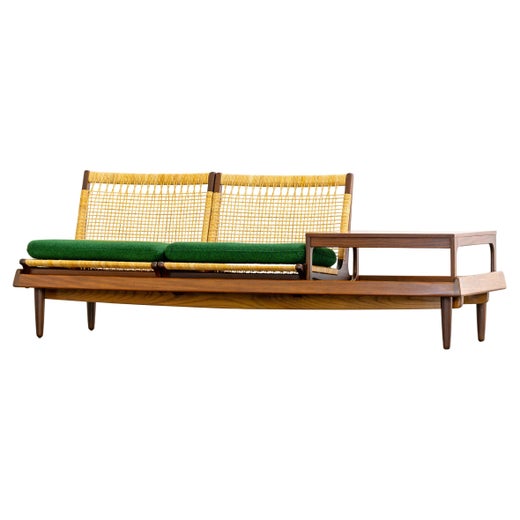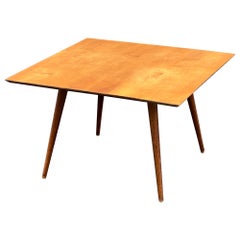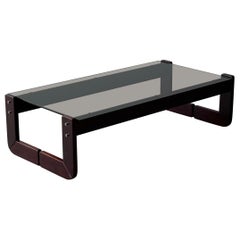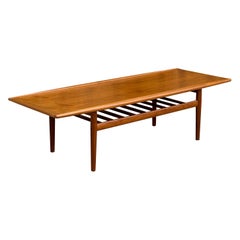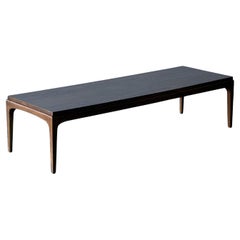Mid-Century Coffee Table by Henry Walter Klein for Bramin
About the Item
- Creator:Bramin Mobler (Manufacturer),Henry Walter Klein (Designer)
- Similar to:Percival Lafer (Designer)Milo Baughman (Designer)
- Dimensions:Height: 12.5 in (31.75 cm)Width: 27.5 in (69.85 cm)Depth: 27.5 in (69.85 cm)
- Style:Mid-Century Modern (Of the Period)
- Materials and Techniques:
- Place of Origin:
- Period:
- Date of Manufacture:Circa 1970s
- Condition:Wear consistent with age and use. In overall good vintage condition with minor wear present. Very faint scratches on glass top typical of age and use.
- Seller Location:Raleigh, NC
- Reference Number:1stDibs: LU6888243211992
Bramin Mobler
Bramin Møbler manufactured covetable Scandinavian modern furniture from the mid-1950s until the early 1980s.
Originally founded as N.A. Jørgensen Møbelfabrik in Bramming, Denmark, the company rebranded as Bramin Møbler in the late 1950s. During the 1960s, Bramin Møbler’s offerings retained the simplicity and warmth commonly associated with Scandinavian cabinetmaking traditions and the N.A. Jørgensen Møbelfabrik name but its collaborations with forward-thinking designers helped steer it toward adopting the Danish modern style that had captivated new homeowners in the United States during the postwar years.
Bramin Møbler prioritized quality, form and function — attributes that were promoted by the firm in its print ad campaigns. Its credenzas, dining tables and sideboards were made from strong, rich woods like oak, rosewood and teak (a highly prized material in the mid-century modern era), while its artisans upholstered the company’s durable seating with inviting materials such as wool and leather.
Bramin Møbler collaborated with many legends of Scandinavian and Nordic design, including Johannes Andersen, Hans Olsen, Kurt Østervig and Frank Reenskaug. Its most successful partnership was with Norwegian furniture designer H. W. Klein, who studied under Finn Juhl — a stylistic maverick and master of mid-century Danish design — and moved to Bramming to work for Bramin Møbler.
Over the course of two decades, Klein created elegant coffee tables and cabinets for Bramin Møbler that featured clean lines and gracefully tapered legs, but he is best known for his lounge chairs — most notably, his leather-padded swivel lounger, with its five-spoked, wheeled base.
The global recession of the 1980s hit Bramming hard. Many of the region’s numerous furniture manufacturers had to close their doors — Bramin Møbler included. Bramin Møbler creations remain highly sought after by collectors and enthusiasts of Scandinavian and mid-century modern furniture.
Find vintage Frank Reenskaug rocking chairs and other Bramin Møbler furniture such as tables, storage pieces and more for sale on 1stDibs.
You May Also Like
Vintage 1960s Danish Scandinavian Modern Dining Room Tables
Teak
Mid-20th Century Danish Mid-Century Modern Dining Room Tables
Teak
Vintage 1950s Danish Scandinavian Modern Dining Room Tables
Palisander
Mid-20th Century Danish Mid-Century Modern Coffee and Cocktail Tables
Aluminum
Vintage 1970s Danish Mid-Century Modern Coffee and Cocktail Tables
Metal
Vintage 1960s Danish Scandinavian Modern Dining Room Tables
Teak
Vintage 1970s Danish Mid-Century Modern Coffee and Cocktail Tables
Vintage 1960s Danish Scandinavian Modern Dining Room Tables
Metal
Vintage 1960s Danish Mid-Century Modern Dining Room Tables
Oak
Vintage 1950s Danish Mid-Century Modern Dining Room Tables
Oak
More From This Seller
View AllVintage 1950s American Mid-Century Modern Coffee and Cocktail Tables
Wood, Maple
Vintage 1970s Brazilian Mid-Century Modern Coffee and Cocktail Tables
Glass, Smoked Glass, Wood, Rosewood
Vintage 1970s Danish Mid-Century Modern Coffee and Cocktail Tables
Wood, Teak
Vintage 1960s American Mid-Century Modern Coffee and Cocktail Tables
Wood, Walnut
Vintage 1950s Danish Mid-Century Modern Coffee and Cocktail Tables
Wood, Teak
2010s American Mid-Century Modern Coffee and Cocktail Tables
Aluminum
Recently Viewed
View AllRead More
We Spotted This ’70s Percival Lafer Sofa in Michael Shannon’s Brooklyn Home
“It’s had some use over the years, but I think that’s what gives it a lot of the character,” the actor told AD.
Rooms We Love: 11 Splendid Living Rooms
Common wisdom used to declare the kitchen the hub of the house. These days, the living room seems to have assumed the role of domestic focal point. Unlike the Victorian parlor, stiffly furnished and reserved for guests, today’s living room is a central place for reading, conversation and, well, living, with furnishings that lend themselves to both casual lounging and elegant entertaining.
